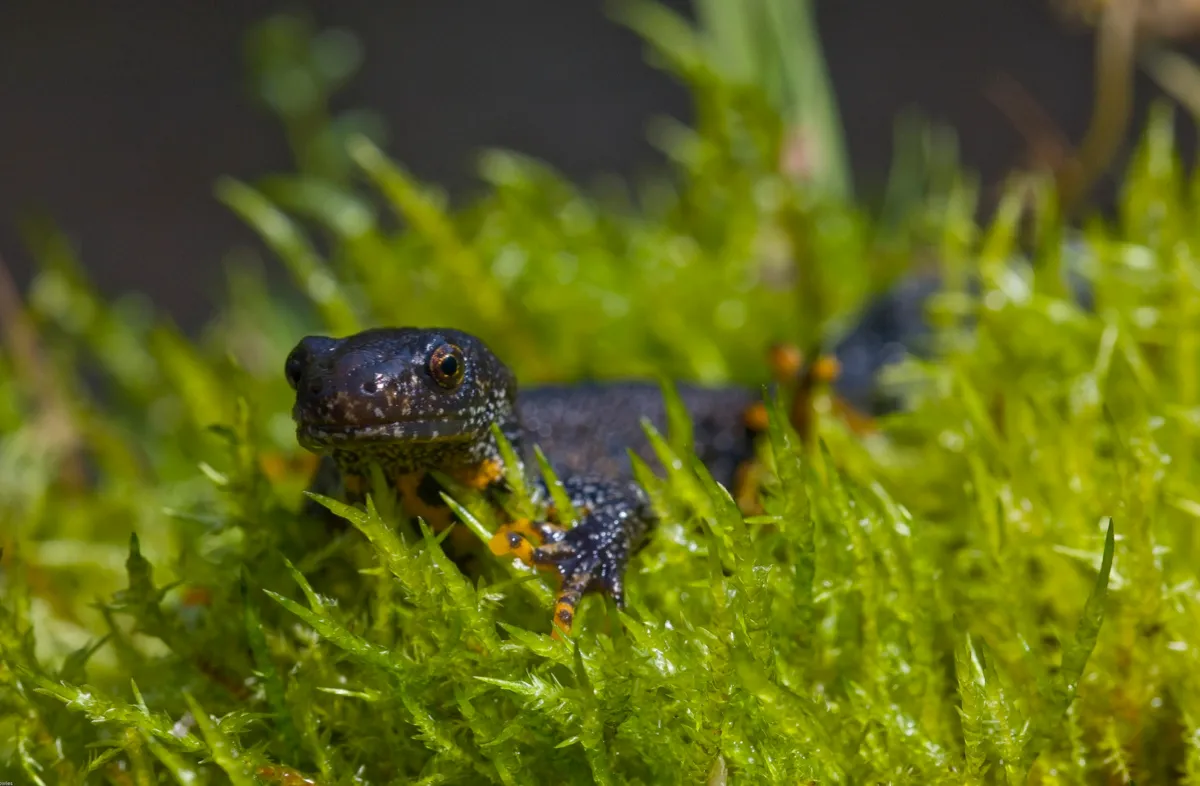The great crested newt, the UK's largest newt species, is an amphibious wonder. Wildlife writer, Adele Brand, explains why.

What is a great crested newt?
There is no disputing that the great crested newt is a head-turner. Nothing else in the British Isles comes so close to impersonating a toy Spinosaurus: stocky body, bumpy skin and preposterous little forelimbs.
It can regenerate limbs and, if faced with a predator, can excrete a poisonous toxin from their skin.
How big is a great crested newt?
Any confusion with smooth and palmate newts – which are much more likely to exploit garden ponds – ends when the adult great crested steps on a ruler. A big female can reach 17cm, although the males are a little smaller.
What does a great crested newt look like?
Silvery black when seen from above, their bellies are garish leopard-print with unique patterns of spots. Researchers use this to identify individuals, rather like a police officer will note a suspect’s tattoos.
By late summer, adult newts have strayed from the water’s edge, experiencing grass and trees from what we would barely call ankle-height. To a newt, 100 metres is an epic journey. To us, it is a lesson in the fine details of the landscape, of the subtle value of ditches, mammal burrows and old rotting wood.

And then there is the crest. A male newt does not skimp on style for the breeding season. His back is crowned by a jagged crest that resembles a panorama of some fearsome mountain range, and his long tail is striped white.
When are you likely to see a great crested newt?
Between March - October.
Where do great crested newts live?
This rambler sets forth when the skies are dark and vegetation is bowed with summer drizzle, accumulating steps between disused mineral pits, old grasslands and fish-free ponds.
Great crested newts – perhaps our most unsung hikers (they can roam as far as 1km) – take to dry land as their breeding season finishes around the end of June, leaving ponds to their spotted, frilly-gilled, ever-hungry tadpoles.
What do great crested newts eat?
They gulp down invertebrates and any fellow amphibians. Adults are equally hungry, predating slugs, earthworms and smaller newts.
When not eating, newts are wandering. Theirs is a perspective on the land crafted by other species; vole paths in tussocky grass give them passage, mammal burrows offer foraging for invertebrates, and toads guide them to potential breeding ponds by their calls.
How long do great crested newts live?
Their lifespan is up to 17 years – far longer than a fox or badger.
Do great crested newts have mating rituals?
Yes, and quite extravagant ones at that. Moving to open water, a male will stand on their front legs, wave his tail and rock his body in elegant advertisement. A female that accepts him touches his tail with her nose.
She can lay 250 eggs, often wrapping them in folded plant leaves. Sadly, despite her efforts, half of all eggs die due to a chromosome anomaly. Those that hatch must evade dragonfly larvae and fish.
Are great crested newts endangered?
Due to their declining population, great crested newts are classified as a protected species in the UK (Wildlife and Countryside Act, 1981) and across Europe (European Habitats Directive).
They're also recognized as a priority for conservation efforts within the UK (UK Post-2010 Biodiversity Framework).
What to do if you find a great crested newt
It's against the law to touch, move or harm great crested newts.
If you're planning earthworks and find a great crested newt, you'll need to follow the advice as set out by the Government:
"You should immediately stop work if you find great crested newts in the pond before or after you start work if you’re doing pond management work without a licence. You should start your work at a different time or do it in a different way to avoid harming the newts. If you can’t avoid harming the newts then you’ll need to get a conservation licence."
Love a lizard?
Check out our expert guides to the sand lizard and the common lizard. Plus, discover the difference between a frog and a toad. And, if you're looking to help the great crested newt, find out how to make a wildlife pond in your garden.

